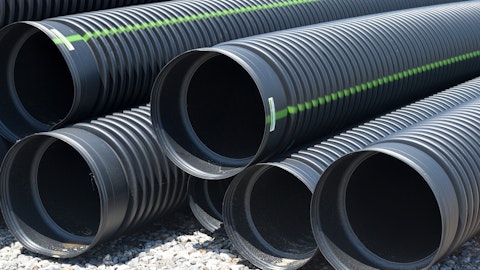Scott Cottrill: Yes. Hey, Scott C. here, Michael. The pricing resiliency of the company and based on that value prop is truly amazing. And we’ve proven it over time, but I would say that value prop, the inflationary cost environment really have come into play really well, and we continue to see that. I think we also talk about how much of our quoting and pricing is based on a project-by-project basis, geography, costs, everything else and by product. So again, we continue to see the ability to drive on certain products, in certain geographies, pricing even up sequentially. So it’s holding in there. I think on your broader question on price/cost in general, absolutely, the pricing piece is hanging in there and up year-over-year.
And we’re really starting to see that resi cost come off like we knew it would, and we’ve got good visibility as to what’s on the balance sheet. But again, we saw that starting to come through like we thought. And then we’ll see even bigger piece of that started coming off the balance sheet here in Q4, which again is reflected in our guide. When you look at that midpoint of that Q4 implied guidance, you see that our decremental margins are more in that 25% range as opposed to that 30%, 35% range we normally talk to. And again, it’s the strength of that price/cost dynamic.
Michael Halloran: And then last one for me. Could you put the cost saving initiatives in context. One, any dollar number you’re willing to provide, but secondarily at the Analyst Day, you guys talked about, what was it, 7%, 8% kind of capacity growth type range. I’m guessing some of these capacity reduction moves are in areas that you’re maybe considering moves all along. But how does this change the thought of what that capacity curve looks like over time? Or does it even and it’s just shifting the timing and shifting the areas?
Scott Barbour: So Scott B. here, let me answer that capacity question. And I would call — think about Infiltrator, flattening out some stuff pushing out versus what we previously considered in call it, the March Investor Day or on the trip down there. In the ADS side, probably still capacity being added in Florida, the Southeast, the places that are showing a lot of growth, maybe some minimal changes around and then the plants that will close and — or things that we’ve been — it’s been on our list, we’ve now had the opportunity to go to. You want to talk about that?
Scott Cottrill: Yes. I’d say on the cost side, we’re not giving specific dollars, Michael. But the way that we kind of put the guardrails around it or frame it up, right? We talked about the three plants that are coming out. We talked about 15% of our headcount. The way I’d give it a little bit more context is about two-thirds of the total cost outs that we’re targeting will be in that cost of sales variable cost area and about a third of those cost-outs that we’re currently targeting would be in the SG&A fixed cost arena. So — and right now, it’s based on kind of what we saw, especially in December and proving out in January coming in, as Scott said largely as we expected based on that current lower demand environment. We think this is the appropriate level of cost outs at this time.
Michael Halloran: Thank you, really appreciate it.
Scott Barbour: Yes. Thanks, Michael.
Operator: Thank you. The next question today comes from the line of Matthew Bouley from Barclays. Please go ahead. Your line is now open.




